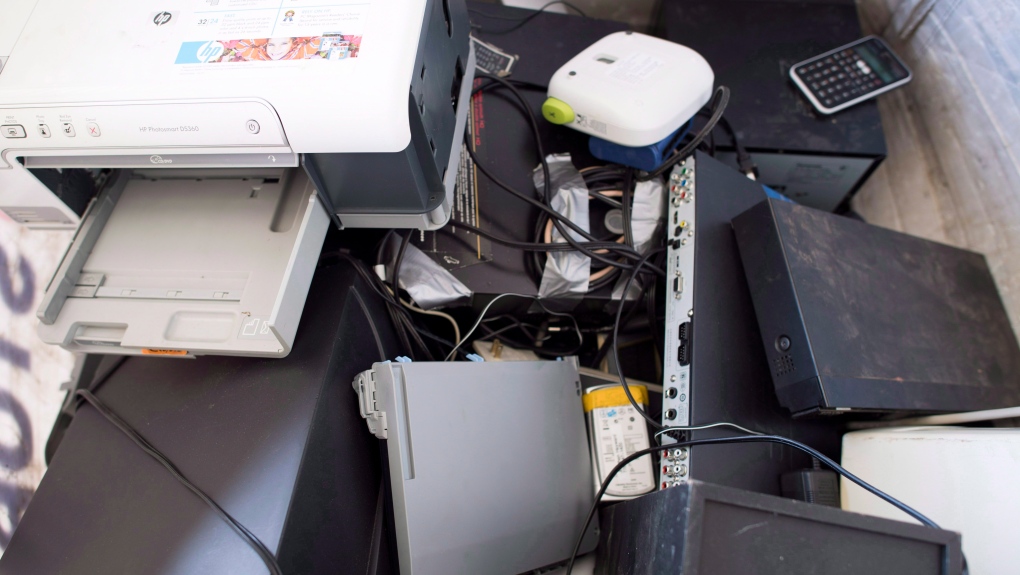
Quebec nurse had to clean up after husband's death in Montreal hospital
On a night she should have been mourning, a nurse from Quebec's Laurentians region says she was forced to clean up her husband after he died at a hospital in Montreal.
A new study from researchers at the University of Waterloo suggests the amount of electronic waste in Canada has more than tripled in the last 20 years.
Their study, published in the Journal of Hazardous Materials, suggests that e-waste is “steadily growing” in Canada. The researchers say close to a million tonnes of e-waste was generated in Canada in 2020, and less than 20 per cent of that was collected and recycled.
According to the authors, this amount of e-waste is equivalent to “filling the CN tower 110 times”.
The researchers say the purpose of the study was to understand the life-cycle, from sale to disposal, of electronic items in Canada, such as computers, cellphones, toys, refrigerators and washing machines.
According to the study, the amount of e-waste generated per person has increased from 8.3 kilograms in 2000 to 25.3 kg in 2020, and researchers estimate it will increase again in the near future.
They say they believe that the growth of e-waste is attributed to consumer habits, as well as the increases in the number of households.
“This study provides useful insights to policymakers for setting up targets for e-waste reduction and recycling to recover valuable resources from e-waste,” Komal Habib, a professor at the University of Waterloo’s School of Environment, Enterprise and Development, said in a news release published Monday. “E-waste could also help to create a secondary supply chain of critical materials, reducing the risks of potential supply disruptions.”
The study looked at e-waste from 198 product types from 1971 to 2030 and estimated that e-waste will increase to 1.2 million tonnes by 2030 in Canada.
Globally, the amount of e-waste generated annually is estimated to be 2.5 million tonnes, and will increase up to 74.7 million tonnes by 2030, according to the study.
Researchers suggest that more attention should be given to improving repair, refurbishment and product life extension opportunities rather than focusing solely on recycling and material recovery.
“The findings will be beneficial for stakeholders to explore possible material and revenue generation opportunities from e-waste,” added Habib. “For example, it can help electronic manufacturers and recyclers to understand the potential for urban mining, plan for future extractions of critical materials, and identify the need for safe handling of any hazardous materials.”
Reporting for this story was paid for through The Afghan Journalists in Residence Project funded by Meta.

On a night she should have been mourning, a nurse from Quebec's Laurentians region says she was forced to clean up her husband after he died at a hospital in Montreal.
A North Bay, Ont., lawyer who abandoned 15 clients – many of them child protection cases – has lost his licence to practise law.
Members of the Bank of Canada's governing council were split on how long the central bank should wait before it starts cutting interest rates when they met earlier this month.
Brad Marchand scored twice, including the winner in the third period, and added an assist as the Boston Bruins downed the Toronto Maple Leafs 4-2 to take a 2-1 lead in their first-round playoff series Wednesday
Cuba's foreign affairs minister has apologized to a Montreal-area family after they were sent the wrong body following the death of a loved one.
Mounties in Nanaimo, B.C., say two late-night revellers are lucky their allegedly drunken antics weren't reported to police after security cameras captured the men trying to steal a heavy sign from a downtown business.
The federal government's proposed change to capital gains taxation is expected to increase taxes on investments and mainly affect wealthy Canadians and businesses. Here's what you need to know about the move.
Canada's Deputy Prime Minister Chrystia Freeland was among the 1,700 delegates attending the two-day First Nations Major Projects Coalition (FNMPC) conference that concluded Tuesday in Toronto.
The daughter of a New Brunswick man recently exonerated from murder, is remembering her father as somebody who, despite a wrongful conviction, never became bitter or angry.

A property tax bill is perplexing a small townhouse community in Fergus, Ont.
When identical twin sisters Kim and Michelle Krezonoski were invited to compete against some of the world’s most elite female runners at last week’s Boston Marathon, they were in disbelief.
The giant stone statues guarding the Lions Gate Bridge have been dressed in custom Vancouver Canucks jerseys as the NHL playoffs get underway.
A local Oilers fan is hoping to see his team cut through the postseason, so he can cut his hair.
A family from Laval, Que. is looking for answers... and their father's body. He died on vacation in Cuba and authorities sent someone else's body back to Canada.
A former educational assistant is calling attention to the rising violence in Alberta's classrooms.
The federal government says its plan to increase taxes on capital gains is aimed at wealthy Canadians to achieve “tax fairness.”
At 6'8" and 350 pounds, there is nothing typical about UBC offensive lineman Giovanni Manu, who was born in Tonga and went to high school in Pitt Meadows.
Kevin the cat has been reunited with his family after enduring a harrowing three-day ordeal while lost at Toronto Pearson International Airport earlier this week.
 Wires and electronic e-waste is pictured at the North Vancouver, recycle depot, Thursday, Oct. 4, 2018. THE CANADIAN PRESS Jonathan Hayward
Wires and electronic e-waste is pictured at the North Vancouver, recycle depot, Thursday, Oct. 4, 2018. THE CANADIAN PRESS Jonathan Hayward